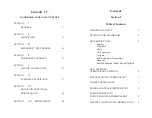
RC-Xplanes EDGE 540 T Outrunner Tabs Instruction Manual
Page 7 of 10
Distributed by RC-Xplanes 541-261-2707
rcxplanes.com
A
2005
Step 6: Control Surface Hinging.
6A:
Some people have used CA to attach the DuBro hinges but I have yet to find a reliable way to get the CA into the hinge slot with the
hinge installed and the CA cures too fast to install a coated hinge and properly align everything so I use the epoxy method as outlined
here.
Prepare the 15 small DuBro hinges by applying some wax, Vasoline or in this case Blistex, to the barrel portion. Fold the hinge over
and do the same thing again. Work the lubricant into the barrel by folding the hinge back and forth a couple of times and set it aside,
partially folded on its edge. Do not get the lubricant on any of the hinge that you want adhesive to stick. Repeat this for all of the hinges.
Use RC-Xplanes 5 minute epoxy to mount the hinges into the control surface. This step requires that you move quickly to distribute the
epoxy before it sets up. Mix enough epoxy to do 4 hinges at a time. Use a "T” pin or a discarded #11 blade to apply some of the epoxy
into the slots in one of the ailerons. Apply a little epoxy to both sides of one of the hinge tabs and slip it into the slot about ¾ depth.
Excess epoxy can be removed from both sides of the hinge with a pocket screwdriver or similar tool. Insert the hinge in to the slot until
the barrel is almost touching. Move quickly to get all four hinges into the surface, then sight down the hinge line and align them as close
as you can by eye. The hinge will function fine with some alignment offset in the hinges and this works great every time. Set the aileron
aside and repeat this for the remaining control surfaces.
By the time you finish installing the last hinges, the first control surface should be ready to install to the plane. They will look similar to
this. Use the same techniques of installing 4 hinges or less at a time and install all of the control surfaces and allow them to cure.
Make sure each aileron end is aligned with the wing end and that there is clearance between the control surface counterbalances and
the stabilizer ends for each elevator half and the rudder.
6C:
In this step you will test fit the elevator joiner to the elevators and prepare some waxed paper spacers and tape to hold everything
aligned while the adhesive is hardened.
Hang both elevator halves at 90 degrees to the stabilizer exposing the groves for the joiner tube. Slip the tube through the hole in the
fuselage and lay it into the grooves in each elevator half. Rotate the elevators up and align with the stabilizer. Prepare some folded
waxed paper spacers to fit snugly between the elevator joiner tube and the stabilizer. Also prepare two pieces of tape to tape the
elevators to the stabilizer. Remove the waxed paper and hang the elevators down and remove the carbon joiner tube.
Use 150 or 200 grit sandpaper and sand the elevator joiner tube with lengthwise scuffs for the adhesive to grip. With the Elevators
hanging down at 90 degrees to the stabilizer, run a bead of medium CA in the joiner grooves. Slip the joiner tube through the fuselage
hole and into both joiner grooves. Begin rotating both elevator halves up into place while slipping the pre-prepared waxed paper into
place. Continue rotating the elevator halves up and align with the stabilizer. Make sure the waxed paper is lightly pushing the joiner
tube into the bottom of the joiner tube grooves. Tape the elevators to the stabilizer and insure the joiner tube is perpendicular to the
stabilizer trailing edge. Remove any excess CA with a paper towel. Apply CA accelerant and allow to fully cure for 4 – 5 minutes before
disturbing.
Step 7: Motor & Radio Gear Installation
7A:
Connect your motor and speed control. Mount the motor using the four nylon screws supplied. Mark the location of the Speed
Control. Apply a piece of self adhesive Velcro to the controller and fuselage where it will live. Attach the receiver just in front of
the wing trailing edge with the servo connector pins facing rearward. All of the following measurements are for a four HiTec HS55
setup. If you decide on a different setup, you are on your own as to their placement. Make a hole at 1 inch behind the wing spar
through both 45 degree supports and the fuselage large enough to pass the Dean’s battery connector through. Make a small
rectangle cutout in the fuselage just behind the receiver pins for the right wing and elevator servo connectors to pass through.




















